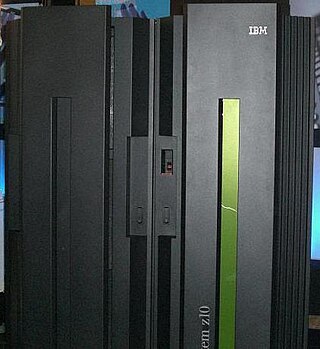
AIX is a series of proprietary Unix operating systems developed and sold by IBM for several of its computer platforms.
IBM mainframes are large computer systems produced by IBM since 1952. During the 1960s and 1970s, IBM dominated the computer market with the 7000 series and the later System/360, followed by the System/370. Current mainframe computers in IBM's line of business computers are developments of the basic design of the System/360.

VSEn is an operating system for IBM mainframe computers, the latest one in the DOS/360 lineage, which originated in 1965. It is less common than z/OS and is mostly used on smaller machines.

Hercules is a computer emulator allowing software written for IBM mainframe computers and for plug compatible mainframes to run on other types of computer hardware, notably on low-cost personal computers. Development started in 1999 by Roger Bowler, a mainframe systems programmer.
The Integrated Facility for Linux (IFL) is an IBM mainframe and Power Systems processor dedicated to running the Linux operating system. On IBM Z and IBM LinuxONE machines, IFLs can be used with or without hypervisors such as z/VM and KVM. IFLs are one of three most common types of "specialty" IBM mainframe processors that give software vendors more granular control over software licensing and maintenance costs.. Microcode restricts IFLs to Linux workload by omitting some processor instructions not used by the Linux kernel, but the underlying processors are physically identical to general purpose processors (CPs). When IBM adds features and performance improvements to its mainframes' general purpose main processors, those features and improvements nearly always apply equally to IFLs. In fact, in recent IBM Z machines IFLs support simultaneous multithreading, a feature not available for general purpose processors.
A hypervisor, also known as a virtual machine monitor (VMM) or virtualizer, is a type of computer software, firmware or hardware that creates and runs virtual machines. A computer on which a hypervisor runs one or more virtual machines is called a host machine, and each virtual machine is called a guest machine. The hypervisor presents the guest operating systems with a virtual operating platform and manages the execution of the guest operating systems. Unlike an emulator, the guest executes most instructions on the native hardware. Multiple instances of a variety of operating systems may share the virtualized hardware resources: for example, Linux, Windows, and macOS instances can all run on a single physical x86 machine. This contrasts with operating-system–level virtualization, where all instances must share a single kernel, though the guest operating systems can differ in user space, such as different Linux distributions with the same kernel.
z/Architecture, initially and briefly called ESA Modal Extensions (ESAME), is IBM's 64-bit complex instruction set computer (CISC) instruction set architecture, implemented by its mainframe computers. IBM introduced its first z/Architecture-based system, the z900, in late 2000. Later z/Architecture systems include the IBM z800, z990, z890, System z9, System z10, zEnterprise 196, zEnterprise 114, zEC12, zBC12, z13, z14, z15 and z16.
PowerLinux is the combination of a Linux-based operating system (OS) running on PowerPC- or Power ISA-based computers from IBM. It is often used in reference along with Linux on Power, and is also the name of several Linux-only IBM Power Systems.
A logical partition (LPAR) is a subset of a computer's hardware resources, virtualized as a separate computer. In effect, a physical machine can be partitioned into multiple logical partitions, each hosting a separate instance of an operating system.

IBM System z9 is a line of IBM mainframe computers. The first models were available on September 16, 2005. The System z9 also marks the end of the previously used eServer zSeries naming convention. It was also the last mainframe computer that NASA ever used.
Dynamic Logical Partitioning (DLPAR), is the capability of a logical partition (LPAR) to be reconfigured dynamically, without having to shut down the operating system that runs in the LPAR. DLPAR enables memory, CPU capacity, and I/O interfaces to be moved nondisruptively between LPARs within the same server.
IBM S/390 Multiprise was a short-lived series of small, compact, entry-level mainframes.
Since the rise of the personal computer in the 1980s, IBM and other vendors have created PC-based IBM-compatible mainframes which are compatible with the larger IBM mainframe computers. For a period of time PC-based mainframe-compatible systems had a lower price and did not require as much electricity or floor space. However, they sacrificed performance and were not as dependable as mainframe-class hardware. These products have been popular with mainframe developers, in education and training settings, for very small companies with non-critical processing, and in certain disaster relief roles.
In IBM System z9 and successor mainframes, the System z Integrated Information Processor (zIIP) is a special purpose processor. It was initially introduced to relieve the general mainframe central processors (CPs) of specific Db2 processing loads, but currently is used to offload other z/OS workloads as described below. The idea originated with previous special purpose processors, the zAAP, which offloads Java processing, and the IFL, which runs Linux and z/VM but not other IBM operating systems such as z/OS, DOS/VSE and TPF. A System z PU is "characterized" as one of these processor types, or as a CP, or SAP. These processors do not contain microcode or hardware features that accelerate their designated workloads. Instead, by relieving the general CP of particular workloads, they often lead to a higher workload throughput at reduced license fees.

IBM Z is a family name used by IBM for all of its z/Architecture mainframe computers. In July 2017, with another generation of products, the official family was changed to IBM Z from IBM z Systems; the IBM Z family now includes the newest model, the IBM z16, as well as the z15, the z14, and the z13, the IBM zEnterprise models, the IBM System z10 models, the IBM System z9 models and IBM eServer zSeries models.
The following is a timeline of virtualization development. In computing, virtualization is the use of a computer to simulate another computer. Through virtualization, a host simulates a guest by exposing virtual hardware devices, which may be done through software or by allowing access to a physical device connected to the machine.
PowerVM, formerly known as Advanced Power Virtualization (APV), is a chargeable feature of IBM POWER5, POWER6, POWER7, POWER8, POWER9 and Power10 servers and is required for support of micro-partitions and other advanced features. Support is provided for IBM i, AIX and Linux.
OpenSolaris for System z is a discontinued port of the OpenSolaris operating system to the IBM System z line of mainframe computers.

IBM System z10 is a line of IBM mainframes. The z10 Enterprise Class (EC) was announced on February 26, 2008. On October 21, 2008, IBM announced the z10 Business Class (BC), a scaled-down version of the z10 EC. The System z10 represents the first model family powered by the z10 quad core processing engine. Its successors are the zEnterprise System models introduced in 2010 and 2012.





